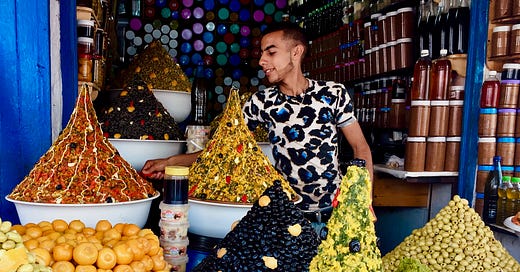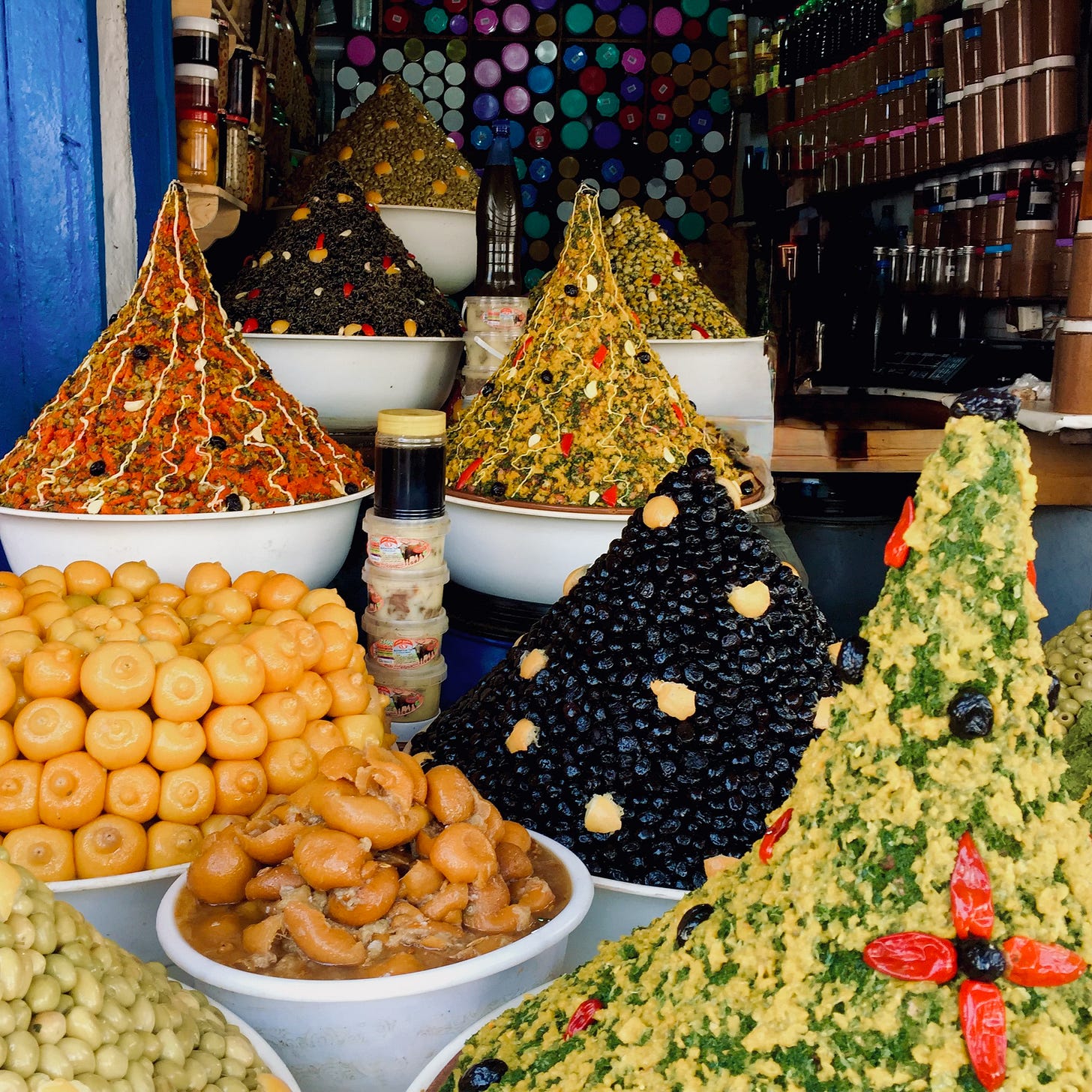Think You Know How to Use Preserved Lemons?
A Moroccan Reflection on Taste, Identity, and Transformation
There’s something magical about the light in the windy city of Essaouira. Maybe it’s the Atlantic mist, maybe it’s the blue walls faded by wind and salt. Once known as Mogador, it is one of those rare places with a soul.
It has drawn dreamers from around the world. Orson Welles filmed Othello in the fifties. Jimi Hendrix floated through in the golden haze of the sixties. They came for the waves, the light, the colors.
Essaouira has been my adopted home for years. Every time I walk through the spice stalls of the ancient medina, I feel hypnotized by the melody of the waves crashing against the 18th century stone ramparts.
And yet, even with all that legend swirling around, it’s the preserved lemons that always stop me - stacked like golden marbles, nestled between pyramids of olives: the cured black ones, the harissa-laced mix, the garlicky greens with red chilies arranged like little edible flowers.
You’ll want to take all of them, and the shop owner will gladly let you taste every single one. Just make sure you bring some bread.
It’s always the same scene: a tourist pauses, tilts their head, and asks, “what are those?”
They don’t realize they’re looking at the soul of a cuisine.
Inside those glossy preserved lemons lives salt, patience, and ancestral common sense.
This ancient preservation method concentrates the flavors, mellows the acidity, and diminishes the bitterness of the peel.
The lemons taste as if they have been through something and came out wiser- softer and more forgiving. It is a transformation through preservation. Perhaps we should call them transformed lemons.
It is a transformation through preservation.
Perhaps we should call them transformed lemons.
They are an indispensable ingredient in Moroccan cooking, especially for flavoring some dishes and salads. We add them into chicken and olive tagines, or shred the rind into herb-laced salads such as the carrots with chermoula (our North African chimichuri), zaalouk (eggplant caviar), fresh fava beans, and bakkoula (a sautéed spinach and kale salad).
We mix the pulp into marinades, drizzle their brine into sauces. But one thing we never do, is question their place in the kitchen. They are the kitchen.
You buy them when you don’t have time, but it’s always preferable to prepare them at home.
I’m a Paula Wolfert fangirl. I return to her work every time I write about Moroccan food. I often think of her, wish her good health, and secretly hope I’ll get to meet her one day.
Now, back to preserved lemons.
When Wolfert wrote about food, it was a different time. People approached other cultures with curiosity and care, not for clicks. Nobody was belly dancing for the algorithm. Hashtags hadn’t replaced humility. And the term "cultural appropriation" hadn’t yet entered the conversation.
Writers like Wolfert weren’t trend-chasing. They were trendsetters. They paid attention and wrote with reverence.
In her glorious book The Food of Morocco, she writes:
In Morocco many types of lemons are preserved in salt for use in salads, couscous, fish dishes and tagines. I'd go so far as to say that preserved lemons are the most important condiment in the Moroccan larder. Fresh lemons are never an adequate substitute. The taste, texture and aroma of preserved lemons are unique and cannot be duplicated by other means (no matter what some food writers tell you).
And she’s right. No matter what some food writers say.
What is the point of preserved lemons?
I beg your pardon. Is that even a question?
If you search “preserved lemons,” the first thing that comes up is “what is the point of preserved lemons?” Since when have we decided to simplify a millennial tradition into a point? Does everything need to have a point?
According to whoever decided to explain the “point,” preserved lemons “add a big punch of flavor, instant umami, and complexity to any dish.”
When was the last time you had a good meal and said, “Wow, the umaminess is really out of this world”?
The answer is sterile at best. In Morocco, we say it’s yummy, not umami.
Culinary appropriation has gone off limits.
Let me be clear: preserved lemons are not a trend. They are not some elevated “Mediterranean lemon confit” or some flavormaxing trick to make your food “pop” (read Dianne Jacob’s What is Flavormaxing and Will it Impact Recipe Writing?).
Preserved lemons are a region’s heritage, salted and sealed in glass. They are how we remember. And when I see food writers, celebrity chefs, or TikTok’s latest kitchen clown tossing them into a dish with zero context, no mention of Morocco, no nod to North Africa, I get tired.
If you’re asking what the point of preserved lemons is, you’re asking the wrong question. The point is: not everything needs a point. Some things just need to be honored.
So when you use them, make sure they carry preserved heritage too.
With love & peace
Sanaa 💛🌴
Preserved lemons recipe:
To make preserved lemons, for the first time I recommend starting with 5 lemons. Use a one-pint heat-proof glass jar with airtight lid and leak proof rubber gasket. You can either sterilize the jar in boiling water or run it through a dishwasher cycle. Also, pick fresh unwaxed lemons.
Once you preserved lemons are transformed, use a clean fork to take them out of the jar to avoid contamination.
Some say you should rinse preserved lemons before using them. I don’t. I just skip the salt in the recipe instead.
Container type:
One-pint heat-proof glass jar with an airtight lid and leak-proof rubber gasket.
Ingredients
5 medium unwaxed lemons, washed and dried
1/2 cup salt, more if needed
Method
1. Sterilize the jar in boiling water or running it through a dishwasher cycle. Dry thoroughly and set aside
2. Remove and discard the stem ends of the lemons.
3. Slice each lemon into quarters lengthwise but not all the way through. Leave enough uncut rind at the base to hold the lemon together.
4. Over a large bowl, use your fingers to gently squeeze the juice from each undetached lemon wedge, collecting the juice in the bowl.
5. Still working over the bowl, generously fill each juiced lemon with approximately 1 tablespoon of salt.
6. Close the lemons, and pack them tightly in the glass jar.
7. Pour the collected salty lemon juice over the lemons. Add more juice if necessary to completely cover the lemons. Finish by adding two teaspoons of salt over the top.
8. Seal the jar and store in a cool dark place for two weeks, shaking and turning every two days without opening it.
9. After two weeks, move the jar to the refrigerator. The lemons will be ready to use once the rinds have softened after about one week. Once preserved, they can last for up to eight months.







I love the way you write! Interestingly, preserved lemons are a big part of Vietnamese cuisine also! I'll have to make some preserved lemons when I have the space, time, an apartment, and a jar! If not, do you recommend anywhere to buy them?
Wonderful post Sanaa. Growing up we always had a jar of preserved lemons at the back of our fridge and I grew up using them both in traditional Moroccan dishes but also in things like garlic yoghurt, compound butters, marinades, pasta sauces, a twist on gremolata and, more recently have also increasingly incorporated them in my baking.
My gripe with a lot of the coverage around preserved lemons is that it seems to miss the fact that in Morocco preserved lemons are typically made from one particular type of lemon which is similar to bergamots in flavour. While you can of course preserve any citrus in salt, the flavour can vary hugely depending on which lemon or citrus variety you use.